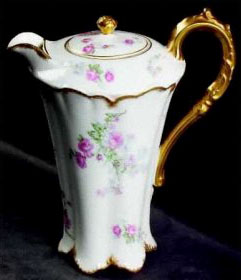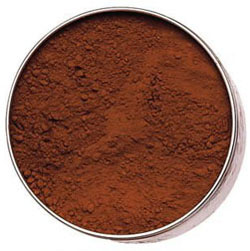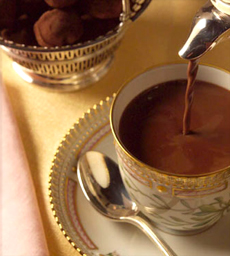This is Page 2 of a six-page article. Click on the black links below to visit other pages.
Continued From Previous Page
 When chocolate was still a beverage for the elite, chocolatières, or chocolate pots, specially designed for serving drinking chocolate, became the vessels of choice for serving them. These were made of precious metals, such as gold and silver; later, after porcelain began to be manufactured, many were made of porcelain and were delicately decorated. Limoges porcelain (Limoges is a region, not a brand) became especially well-known for chocolatières.
When chocolate was still a beverage for the elite, chocolatières, or chocolate pots, specially designed for serving drinking chocolate, became the vessels of choice for serving them. These were made of precious metals, such as gold and silver; later, after porcelain began to be manufactured, many were made of porcelain and were delicately decorated. Limoges porcelain (Limoges is a region, not a brand) became especially well-known for chocolatières.
The porcelain chocolate pot at left, by Haviland Schleiger, is 7-1/2 inches high.
As early as 1657, drinking chocolate was advertised in an English newspaper. London’s first chocolate-house, run by a Frenchman, also opened in that year (although some sources indicate this opening might have occurred five years earlier, in 1652). However, coffee-houses also served chocolate as a beverage (at that time, tea was more expensive than either, so it was consumed only rarely). Both chocolate- and coffee-houses catered to the elite and wealthy, and both were famous for political gatherings and discussions. At the very end of 1675, Charles II, King of England, attempted to suppress coffee-houses as places of “license and seditious libel,” but the public outcry made enforcement of the decree an impossibility. Chocolate-houses proliferated in England during the latter half of the 1600s. The most famous chocolate-house was White’s, opened in 1693 in a fashionable area of London. These institutions would last barely a century. By the end of the 1700s, chocolate-houses were quickly disappearing. Many were transformed into gentlemen’s clubs, and White’s still exists as such a club today.
The Origin Of Cocoa
The reader will note that hot cocoa has not been mentioned up to this time. The reason? It wasn’t until 1828 that a chemist in the Netherlands, Coenrad J. Van Houten, took out a patent for a process to manufacture a chocolate with a much-reduced fat content. This chocolate, which was made in block or cake form, could be easily reduced to a fine powder, which we know as cocoa powder. Cocoa powder could now be made on a large scale, meaning that it would become more affordable to more people.
Originally, Van Houten processed his cocoa with alkaline salts. This alkali-treated cocoa  powder came to be called “Dutch-processed” or “Dutch-process” or ‘Dutched” cocoa, a name it retains to this day. Dutch-process cocoa powder has a darker color, a higher (more alkaline) pH, and is easier to blend into liquids than non-Dutch-process cocoa (which is called “natural” or “nonalkalized”). Dutch-process cocoa powder also has a milder chocolate flavor than does nonalkalized cocoa powder. That’s why bakers and makers of quality ice cream prefer natural cocoa for its more intense chocolate flavor.
powder came to be called “Dutch-processed” or “Dutch-process” or ‘Dutched” cocoa, a name it retains to this day. Dutch-process cocoa powder has a darker color, a higher (more alkaline) pH, and is easier to blend into liquids than non-Dutch-process cocoa (which is called “natural” or “nonalkalized”). Dutch-process cocoa powder also has a milder chocolate flavor than does nonalkalized cocoa powder. That’s why bakers and makers of quality ice cream prefer natural cocoa for its more intense chocolate flavor.
Cocoa powder at right from DeanandDeLuca.com.
While some disparage the Dutching process these days, claiming that it’s used to disguise lower-quality cocoa beans, the fact is that Dutch-process cocoa powder, natural cocoa powder, or indeed, any chocolate, may contain higher or lower quality beans, depending upon the manufacturer. Don’t expect top-quality cocoa powder to be present in an instant hot cocoa mix that sells for $2.99 for eight envelopes and has a shelf-life of eighteen months—just as you wouldn’t expect best-quality cocoa beans to be used in an inexpensive supermarket chocolate bar.
Continue To Page 2c: Drinking Chocolate
Go To The Article Index Above
Lifestyle Direct, Inc. All rights reserved. Photos are the copyright of their respective owners.



 When chocolate was still a beverage for the elite, chocolatières, or chocolate pots, specially designed for serving drinking chocolate, became the vessels of choice for serving them. These were made of precious metals, such as gold and silver; later, after porcelain began to be manufactured, many were made of porcelain and were delicately decorated. Limoges porcelain (Limoges is a region, not a brand) became especially well-known for chocolatières.
When chocolate was still a beverage for the elite, chocolatières, or chocolate pots, specially designed for serving drinking chocolate, became the vessels of choice for serving them. These were made of precious metals, such as gold and silver; later, after porcelain began to be manufactured, many were made of porcelain and were delicately decorated. Limoges porcelain (Limoges is a region, not a brand) became especially well-known for chocolatières. powder came to be called “Dutch-processed” or “Dutch-process” or ‘Dutched” cocoa, a name it retains to this day. Dutch-process cocoa powder has a darker color, a higher (more alkaline) pH, and is easier to blend into liquids than non-Dutch-process cocoa (which is called “natural” or “nonalkalized”). Dutch-process cocoa powder also has a milder chocolate flavor than does nonalkalized cocoa powder. That’s why bakers and makers of quality ice cream prefer natural cocoa for its more intense chocolate flavor.
powder came to be called “Dutch-processed” or “Dutch-process” or ‘Dutched” cocoa, a name it retains to this day. Dutch-process cocoa powder has a darker color, a higher (more alkaline) pH, and is easier to blend into liquids than non-Dutch-process cocoa (which is called “natural” or “nonalkalized”). Dutch-process cocoa powder also has a milder chocolate flavor than does nonalkalized cocoa powder. That’s why bakers and makers of quality ice cream prefer natural cocoa for its more intense chocolate flavor.